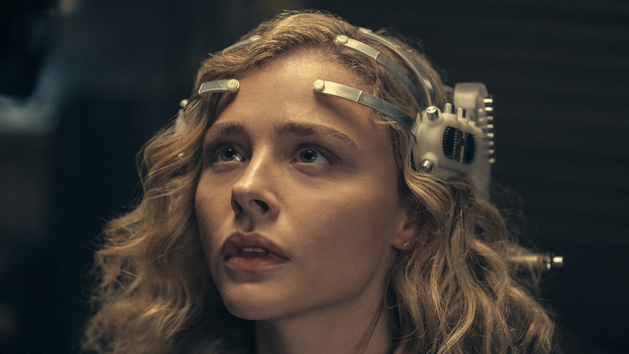The Peripheral will delight sci-fi lovers and William Gibson fans, but what about everyone else?
Opinion: I enjoyed The Peripheral but worry cool tech and twisting timelines just won’t cut it

William Gibson’s 2014 sci-fi novel The Peripheral is cinematic. When I read it, every scene unfolded in my mind’s eye – a testament to my highly-visual imagination, sure, but more so to Gibson’s immersive and complex world-building.
But although the book might evoke powerful visuals, I’ve always thought it would be monumentally challenging to adapt for the screen, with deadly swarms of nanobots and a giant garbage patch in the middle of the ocean floating by within the first 50 pages.
If anyone’s up for a challenge – and with a seemingly endless budget for new projects – it’s Amazon. Hot on the heels of new series Lord of the Rings: The Rings of Power, and with several fantastic sci-fi series under its belt, like The Expanse and Tales From The Loop, an adaptation of The Peripheral lands on Prime Video today (October 21) – and I’ve had early access to the first three episodes.
If you love imagining future technology, then it’s a candy shop of shiny delights – a wearable that doubles as a phone and a games controller, a shiny crystal ball interface, banks of 3D printing machines, and much more.
But strip the first three episodes of their sci-fi set dressing and is there a story that’s fast-paced enough to please fickle streaming audiences? I’m not so sure.
Welcome to the future(s)
Amazon’s upcoming series The Peripheral is about a brother and sister, Flynne (Chloë Grace Moretz) and Burton (Jack Reynor), who live in the Blue Ridge Mountains in the US in 2032.
Burton is a veteran who had haptic technology laced under the surface of his skin to enhance his strength and connect to other soldiers. Flynne works at the local 3D printing shop – that’s a thing in 2032.

Burton makes money by playing games, called ‘sims’ – the first of many new tech terms you’ll need to get your head around fast. One day he can’t carry out a job, so Flynn – who is way better than him at gaming anyway, it turns out – takes over, testing an experimental new game with a futuristic-looking headset – think a consumer EEG headset meets the VR device from Strange Days.
Flynne soon learns this is much more than a regular sim. What follows is a story that spans multiple places in time and space, moving between Flynne’s timeline and another that jumps nearly 70 years into the future to London in 2099.
The complexities of sci-fi storytelling
For the most part, this is how William Gibson’s original story unfolds too. But, presumably to make it more succinct for the screen, several elements of the plot, including some characters, have been canned – disappointingly, a pivotal moment towards the start of the book doesn’t feature in the series at all.
However, condensing a novel down so it can be adapted is standard fare and, in this case, it’s necessary. As great as the book is, parts are dense and confusing – I’m a fast reader and had to re-read certain pages several times over – a streaming show simply doesn’t have time to let you acclimate.
That doesn’t mean The Peripheral is a mindless or easy watch. Like Gibson’s book you are dropped into a fictional, future world. And, as much as I hate being spoon fed a story, there’s a point where it can become overwhelming to learn about new worlds, pick up new terms, get clear on new tech, and understand new power structures well enough to appreciate a character’s place in them in under five minutes.

The pacing doesn't help here either. There were some slower parts and, at times, this worked well, adding gravity to the exposition and greater connection between the characters. Other times, it dragged.
Maybe some people will enjoy the mystery, letting the ideas and story marinate, but that worries me. In the fast-paced, data-driven world of streaming you can’t afford to create a show that people will love with time.
The good news is, I’ve watched past the first episode and I’m here to tell you to stick with it – especially if you love exploring bold sci-fi ideas, like time travel, cybernetics and incredibly cool futuristic interfaces.
A tech-lover’s dream
I enjoyed considering how, in Flynne’s 2032 timeline, technology has both drastically altered some things and yet kept plenty the same.
That’s because it’s believable. Anyone looking at what we’ve achieved in 2022 from back in the early 90s would be disappointed by how far we haven’t come – where are the flying cars? – and, equally, amazed by what we can do now – like order something to be delivered to your doorstep in a matter of hours, fly a drone, 3D print a heart.
The Peripheral shows us the future might not be anywhere near as exciting as we imagine, but life has changed in major ways regardless.

The future of 2099 is packed full of even more future tech but with a take that feels fresh. However, if this stuff doesn’t light you up, if you don’t wonder how we’ll answer calls in the future or visit places virtually or listen in on conversations (all of that nerdy good stuff) then The Peripheral might get very boring very quickly.
Not just surface level sci-fi
Although I believe sci-fi style took priority over storytelling at times throughout The Peripheral, it doesn’t lack substance. It explores several important themes that come with imagining a future in which technological advances have permeated every facet of our lives.
One early example is the trauma experienced by Burton having returned from active duty, and the way his tech enhancements ensure he’s physically stronger but make his transition back to reality complex. Possibly a commentary on both the very real PTSD veterans experience today, as well as an ominous foreshadowing of the way tech might be used to facilitate combat in the not-so-distant future.
This is the power of science-fiction. It can show us fancy gadgetry and a shiny chrome future, but scratch the surface and lessons about inequality, power and freedom run deep. This is one of the great strengths of Gibson’s work that translates well in the first three episodes of The Peripheral. However, whether it’ll translate well to all viewers remains to be seen.
The first episode of The Peripheral is available to stream now on Prime Video. A new episode will be released weekly through December 9.
Get daily insight, inspiration and deals in your inbox
Sign up for breaking news, reviews, opinion, top tech deals, and more.
Becca is a contributor to TechRadar, a freelance journalist and author. She’s been writing about consumer tech and popular science for more than ten years, covering all kinds of topics, including why robots have eyes and whether we’ll experience the overview effect one day. She’s particularly interested in VR/AR, wearables, digital health, space tech and chatting to experts and academics about the future. She’s contributed to TechRadar, T3, Wired, New Scientist, The Guardian, Inverse and many more. Her first book, Screen Time, came out in January 2021 with Bonnier Books. She loves science-fiction, brutalist architecture, and spending too much time floating through space in virtual reality.
